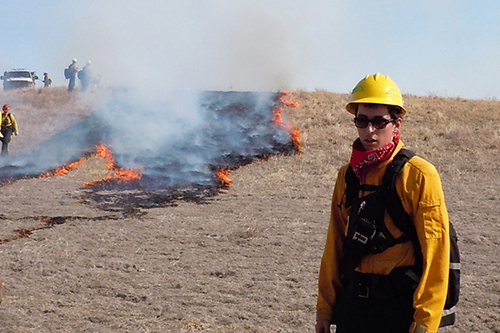
Courtesy Photo
Highlands University forestry student Jonathan Monte-Parker pauses from making a wet line barrier during a controlled burn at the Nature Conservancy’s Niobrara Valley Preserve in northern Nebraska in March.
Las Vegas, N.M. — Two New Mexico Highlands University students participated in a controlled burn at the Nature Conservancy’s Niobrara Valley Preserve in the Sand Hills of northern Nebraska during spring break.
Jonathan Monte-Parker, a senior, and Enriquez Jaramillo, a junior, are both in the wildland fire concentration in the university’s forestry program. They joined professional fire fighters, land managers, and forestry students from several other western universities at the training exercise.
The Nature Conservancy has used strategically planned controlled burns on its properties for 50 years, including burns at Niobrara since 1985. The March burn was mapped extensively in advance and included 4,135 acres of grassland on the preserve.
Forestry professor Sara Brown, a fire ecologist, arranged for her students to participate in the Nature Conservancy prescribed burn to gain experiential learning.
“Nothing replaces being in the field, practicing what they’re learning in the classroom,” Brown said.
“After completing a course and then the weeklong field course in Nebraska, I received my wildland firefighting certificate,” said Monte-Parker, a 23-year-old from Santa Fe who is a volunteer firefighter for the Sheridan Romeroville District south of Las Vegas. “This was my first controlled burn, and it was very valuable for me to get hands-on experience.
“I have a deeper respect for fire, and the training reinforced what I’m learning in my forestry courses. The teamwork aspect of the controlled burn was both rewarding and interesting. I’m really glad that Dr. Brown encouraged me to go,” Monte-Parker said.
“Historically, fires burned at higher frequency, which cleared out the fuels — primarily in ponderosa pine forests – and reduced the potential for catastrophic fires,” Brown said. “With years of fire suppression, what controlled burns do is mimic naturally occurring fires, helping reinstate the natural ecology of vegetation, wildlife and water — all aspects of an ecosystem.”
Jeremy Bailey is the prescribed burn fire training coordinator for the Nature Conservancy’s Fire Learning Network, a public-private partnership with the U.S. Forest Service and the U.S. Department of the Interior. He was the burn boss at the Niobrara burn.
“Fire is a critical component of our ecosystem, like sunshine and rain,” Bailey said. “We need more good fires that restore the function and form to our forests and grasslands. The benefits range from improving wildlife habitat to reducing fuel loads, making communities and watersheds safer.”
Bailey said Monte-Parker and Jaramillo arrived at the burn site during a blizzard, prepared to roll up their sleeves and work.
“I was impressed with Jonathan and Enriquez, and they were great to have on the fire line,” Bailey said. “They performed arduous duties like igniting and extinguishing fires while walking 10 miles every day with 30 pounds of gear on their backs.
“We need more hard working, smart and enthusiastic fire practitioners like Jonathan and Enriquez globally, nationally and locally in New Mexico, where good fires help protect limited water resources,” said Bailey, who worked in New Mexico for 10 years.
This is the second time Highlands University forestry students have participated in controlled burns with the Nature Conservancy. Bailey and Brown both hope the collaboration continues.
“The Fire Learning Network is very excited about how Highlands University is integrating fire management as an important part of its forestry curriculum. Sara Brown is one of several forestry professors in the country who are leading the way on this,” Bailey said.
